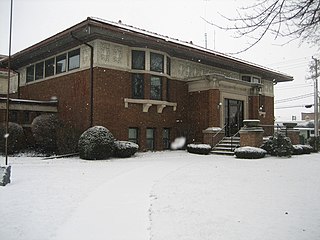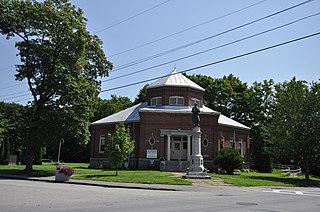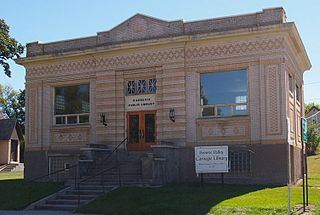History
Between the years 1886 and 1919 Andrew Carnegie gave away $56 million worldwide in library benefactions. There are two main divisions within those years, often described as "retail" and "wholesale," based upon the number of libraries constructed. For the first ten years of his philanthropy Carnegie donated around $1,000,000 which benefacted only six communities in the United States and constructed a total of 14 library buildings. Those years, 1886-1896 are described as the "retail" years. The retail philanthropy was limited to five Pennsylvania communities, Pittsburgh, Allegheny, Johnstown, Braddock and Homestead, and one town in Iowa, Fairfield. [1]
As Carnegie went from his retail to wholesale period of library funding he refined his philanthropical philosophy. Instead of providing funding for large, multi-purpose buildings in larger urban areas he began to focus on providing more and smaller locales with libraries, communities that may not have had much in the way of cultural institutions before Carnegie's benefaction. [1]
Libraries
As it became obvious in the late 1880s that Carnegie intended to give away a portion of his wealth, communities, including those in Illinois, began to scramble for the grants. Towns across Illinois petitioned Carnegie, who from 1897 delegated responsibility for screening applications to his personal secretary James Bertram. Bertram was the man that municipalities dealt with when trying to obtain a library; he was known as efficient to the point of rudeness.
Though Carnegie funded 106 libraries in Illinois, the Multiple Property Submission included just 17 of those libraries scattered in small towns across the state. The libraries included: Oregon Public Library, Arcola Carnegie Public Library, Ayer Public Library, Buffalo Township Public Library, (in Polo), Danville Public Library, El Paso Public Library, Greenville Public Library, Havana Public Library, Hoopeston Carnegie Public Library, Jacksonville Public Library, Lincoln Public Library, Litchfield Public Library, Olney Carnegie Library, Paris Carnegie Public Library, Paxton Carnegie Public Library, Streator Public Library, and the Vienna Public Library. [3]
Before the construction of the Carnegie libraries the condition of libraries in small town Illinois can be described as poor, at least based on the descriptions in correspondence to Bertram regarding the grants. Littered among the glowing self-reviews of various communities are indications of the state of libraries in communities seeking Carnegie grants. [1] For instance, in Oregon, Illinois, the Oregon Public Library was forced to occupy "undesirable rented rooms," first in a drug store and then later in a bank building. [4] The 12,000 volume library in Havana was housed in a small room in city hall, cluttered among other municipal offices and departments. [1] The accuracy of these statements is hard to know as the communities were vying for competitive grants for new libraries, but the correspondence can give some idea of the condition of libraries around the state prior to the influx of Carnegie's money.

The National Register of Historic Places (NRHP) is the United States federal government's official list of sites, buildings, structures, districts, and objects deemed worthy of preservation for their historical significance or "great artistic value".

A Carnegie library is a library built with money donated by Scottish-American businessman and philanthropist Andrew Carnegie. A total of 2,509 Carnegie libraries were built between 1883 and 1929, including some belonging to public and university library systems. 1,689 were built in the United States, 660 in the United Kingdom and Ireland, 125 in Canada, and 25 others in Australia, South Africa, New Zealand, Serbia, Belgium, France, the Caribbean, Mauritius, Malaysia, and Fiji.
The Illinois Historic Preservation Division, formerly Illinois Historic Preservation Agency, is a governmental agency of the U.S. state of Illinois, and is a division of the Illinois Department of Natural Resources. It is tasked with the duty of maintaining State-owned historic sites, and maximizing their educational and recreational value to visitors or on-line users. In addition, it manages the process for applications within the state for additions to the National Register of Historic Places and other federal preservation schemes.

The Paris Carnegie Public Library was opened to the public on June 24, 1904. The building is on the National Register of Historic Places and is still home to the Paris Public Library at 207 South Main Street in Paris, Illinois, located in Edgar County.

The Havana Public Library is a Carnegie library located at 201 W. Adams St. in Havana, Illinois. The library was built in 1902 to house Havana's library program, which began in 1896 and was previously kept in a room of the city hall. The building's construction was funded by an $8,000 grant from the Carnegie Foundation as well as a local library tax. The blond brick building was designed in the Classical Revival style. The front of the building features four bays separated by five Ionic pilasters, an asymmetrical pedimented entrance, and a stepped parapet atop the entrance bay.

Flagg Township Public Library is a library in Rochelle, Illinois. It is a Carnegie library, designed in 1912 by Claude and Starck. The library joined the National Register on October 25, 1973.

The Oregon Public Library is located in Oregon, Illinois, United States, the county seat of Ogle County. The building is a public library that was constructed in 1909. Prior to 1909, Oregon's library was housed in different buildings, none of which were designed to house a library. The library was built using a grant from wealthy philanthropist Andrew Carnegie. The grant was obtained after Oregon's citizens voted to change Oregon's library from a city library to a township library. The building was completed by 1908 but the library did not begin operation until 1909.

The Carnegie Free Library of Beaver Falls is a historic Carnegie library in the city of Beaver Falls, Pennsylvania, United States. Erected as Beaver County's first library building, it was financed by Andrew Carnegie and designed by a leading Pittsburgh architect in grand architectural style that helped to redefine the image of the typical Carnegie library. Numerous community organizations have used its space, which remains in continued use as a library, and it has been named a historic site.

Lincoln Heights Branch Library is the second oldest branch library in the Los Angeles Public Library system. Located in the Lincoln Heights section of Los Angeles, California, it was built in the Classical Revival and Italian Renaissance Revival styles in 1916 with a grant from Andrew Carnegie. One of three surviving Carnegie libraries in Los Angeles, it has been designated as a Historic-Cultural Monument and listed on the National Register of Historic Places.

Cahuenga Branch is the third oldest branch library facility in the Los Angeles Public Library system. Located at 4591 Santa Monica Boulevard in the East Hollywood section of Los Angeles, it was built in 1916 with a grant from Andrew Carnegie. One of three surviving Carnegie libraries in Los Angeles, it has been designated as a Historic-Cultural Monument and listed in the National Register of Historic Places.

James Bertram (1872–1934) was the personal secretary of Andrew Carnegie, the industrialist and philanthropist, from 1897-1914. Bertram also served the Carnegie Corporation of New York from its inception in 1911 as secretary and trustee until his death in 1934. He thus continued to have an important role in Carnegie's philanthropic projects after Carnegie's death in 1919.

The Woodland Public Library is the oldest, and one of the last functioning Carnegie-funded libraries in California. It is on the National Register of Historic Places and is a contributing property of the Downtown Woodland Historic District.

The Paulding County Carnegie Library is a historic Carnegie library in the village of Paulding, Ohio, United States. Constructed in the early twentieth century, it is a simple building that has served as the core of Paulding County's library system since its construction, and it has been designated a historic site.

Patton & Miller was an architectural firm of Chicago, Illinois.

Alice Sarah Tyler was an American librarian and advocate.

The Madison Public Library is located at 12 Old Point Avenue in Madison, Maine. Built with funding support from Andrew Carnegie, it is one of the architecturally most unusual libraries in the state, with a distinctive octagonal tower and non-rectangular angled elements. It was designed by the local firm of Snow and Humphreys and completed in 1906. The building was listed on the National Register of Historic Places in 1989.

The Kewanee Public Library is a Carnegie library located at 102 South Tremont Street in Kewanee, Illinois. The library was built in 1907–08 to house the city's public library, which was formed in 1875 and had previously occupied a room in the town hall. The city's first attempt at building a Carnegie library came in 1901, but it could not secure funding to match Carnegie's $20,000 grant; later in the decade, it approved additional community funding and convinced Carnegie to supply an additional $5,000. Chicago architects Patton & Miller, who were well known for their work on Carnegie libraries, designed the Classical Revival building. The library's design includes an entrance flanked by four stone columns and topped by a portico, stone pilasters to either side of the front windows, and a classical entablature with a frieze and dentillated cornice.

The Browns Valley Carnegie Library is a Carnegie library building in Browns Valley, Minnesota, United States, completed in 1916. It was listed on the National Register of Historic Places in 1985 as the Browns Valley Carnegie Public Library for having local significance in the themes of architecture and education. It was nominated for being the town's most architecturally significant early-20th-century building and an example of the libraries provided to small Minnesota communities by Andrew Carnegie's philanthropy.

















